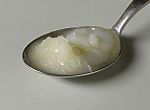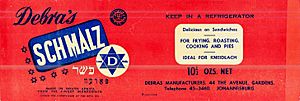Schmaltz facts for kids

Schmaltz derived from goose fat
|
|
| Type | Cooking fat or spread |
|---|---|
| Region or state | Jewish communities in central and eastern Europe, eventually international adoption |
| Created by | Ashkenazi Jews |
| Main ingredients | Fat (chicken, goose, or duck) |
| Nutritional value per 100 g (3.5 oz) | |
|---|---|
| Energy | 3,767 kJ (900 kcal) |
|
0 g
|
|
|
99.8 g
|
|
| Saturated | 30 g |
| Monounsaturated | 45 g |
| Polyunsaturated | 21 g |
|
Protein
|
0 g
|
| Other constituents | Quantity |
| Cholesterol | 85 mg |
| Vitamin E | 2.7 mg |
| Selenium | 0.2 mg |
|
Fat percentage can vary.
|
|
| †Percentages estimated using US recommendations for adults. | |
Schmaltz (also spelled schmalz or shmalz) is a type of cooking fat. It is made by melting down fat from chickens or geese. This fat is a very important part of traditional Ashkenazi Jewish cuisine. For hundreds of years, it has been used in many dishes. You can find it in foods like chicken soup, latkes, matzah brei, and matzah balls. Schmaltz can be used for cooking, as a spread, or to make food taste even better.
Contents
What Does "Schmaltz" Mean?
The word "schmaltz" comes from the German word schmelzen. This word means "to melt." It is related to the English word "smelt," which also means to melt something down.
The term "schmaltz" came into English from Yiddish. Yiddish is a language spoken by Ashkenazi Jews. In Yiddish, shmalts means melted chicken fat. In German, Schmalz can mean any melted animal fat. This includes lard (pork fat) or clarified butter. But in English, "schmaltz" usually means only melted poultry fat.
A Short History of Schmaltz
Historically, chicken was a popular meat for Ashkenazi Jewish people. This was because they often could not own land in Europe. So, they could not raise large animals like cows or pigs.
Schmaltz became popular in Jewish communities in Europe. It was a good and cheap replacement for olive oil. Olive oil was hard to find in these areas. Olive oil had been important in Jewish culture for a long time. It was used by their ancestors in ancient times. It is still popular in Sephardic and Mizrahi cooking today.
Since olive oil and other plant oils were not available, Ashkenazi Jews used animal fats. However, their religious laws, called Kashrut, stopped them from using common fats. They could not use butter with meat dishes. This is because Jewish law says you cannot mix meat and dairy. They also could not use lard, which comes from pork. Pork is not considered kosher.
So, Ashkenazi Jews chose poultry fat, or schmaltz, for cooking. It became the most popular cooking fat in Jewish villages, called shtetls. It was used in many dishes that were served with meat. This followed their kosher dietary laws.
Around the early 1900s, many Ashkenazi Jews moved to the United States. They brought their traditional foods, including schmaltz, with them. Schmaltz was popular in American Jewish cuisine for a while. But then it became less common. It was not easy to make at home. People also worried about its fat content. New diet trends and marketing for Crisco (a vegetable shortening) also made it less popular.
Over time, schmaltz was replaced by plant-based fats. These included vegetable shortening, olive oil, and margarine. People thought these were healthier. But schmaltz stayed popular in Jewish delicatessens and among some Jewish communities.
In the 2000s, schmaltz started to become popular again. Famous chefs like Anthony Bourdain and Michael Solomonov began using it. They brought back many old Jewish foods. Schmaltz is now used in new ways too. It can be found in cornbread, chicken pot pie, and other foods to add flavor.
How is Schmaltz Made?
Making schmaltz involves cutting the fatty parts of a chicken or goose into small pieces. Then, the fat is slowly melted. The liquid fat is collected.
One way to make it is by cooking the fat pieces over low heat. You stir them until the fat melts out. Another way uses steam to melt the fat. After melting, the schmaltz is filtered to make it clear.
When made at home, chicken or goose fat is cut into small pieces. These are melted in a pan over low heat, often with onions. Once most of the fat has melted, it is strained through a cloth. The leftover crispy, dark brown bits of skin and onion are called gribenes.
You can also get schmaltz when making chicken soup. After cooking a chicken, chill the broth. The fat will rise to the top and get solid. You can then skim off this fat. This gives you schmaltz for other uses and a less fatty soup.
How is Schmaltz Used?
Schmaltz has a strong smell and taste. It is often used in hearty dishes like stews or roasts. It is a key ingredient in Jewish soups, such as chicken soup and matzo ball soup.
Sometimes, schmaltz is used as a spread on bread. It can be salted and eaten on Jewish rye or challah bread. It is also used to cook foods for meat meals, following Jewish dietary laws. These foods include latkes, matzah brei, or potato kugel. It can also be used instead of butter when frying potatoes, onions, or other foods.
Vegetarian Schmaltz
There are also plant-based versions of schmaltz. These are called "vegetarian schmaltz." They are also "pareve," meaning they contain neither meat nor dairy. One early example was Nyafat, made in 1924. It was mostly coconut oil with onion flavor and color. Vegetable shortening is also used as a substitute.
In South Africa, "Debra's Schmaltz" was made starting in 1951. Its slogan was "Even the chicken can't tell the difference."
See also
 In Spanish: Schmaltz para niños
In Spanish: Schmaltz para niños


